Introduction
Live chat is a popular channel used by businesses of all sizes across the globe. But how do you know if your customer support team is having better conversations or not? Are you sure that you’re delivering a consistent experience to your customers? To put an end to such questions, here is the perfect solution.
Customer Service Scripts.
Customer service scripts help support teams deliver a standardized experience. Using correct scripts and phrases can solve customer queries and deliver a consistent customer experience. Especially if you’re in retail or e-commerce, you’ll be speaking about customer-related issues daily.
Creating compelling customer service scripts is part of a robust customer service strategy. Here’s a thorough guide and model to help you frame efficient customer service scripts for your business.
Turn aimless conversations into meaningful interactions! Let us begin,
What Are Customer Service Scripts?
Customer service scripts are set of pre-written answers that guide the agents from start to finish when they engage with their customers. The script outlines what the agent is supposed to say. These scripts are made for specific customer service scenarios scripts so that agents do not zone out and can easily tackle complex situations. Customer service scripts ensure that the chances of errors are reduced, and the agent’s efficiency is increased.
Why Are Customer Service Scripts Important?
Customer service scripts help the agents to interact effectively with the customers. They become even more effective in situations where customers are frustrated when agents do not know what to say, etc. In such situations, scripts can be the path agents can follow to stay on top. As scripts include all the answers to the questions of the customers. It helps agents to work more efficiently and offer a consistent experience to the customer.
Advantages of Using Customer Service Scripts
1. Offers a Standardized Experience
Offering an interactive experience every time the customer reaches out to you is crucial. And what better way to provide a consistent experience than customer scripts? Scripting ensures that your brand’s core values are reflected consistently in every customer interaction.
Point to Note: Providing a consistent experience does not mean using the same script repeatedly for all incidents. Make sure that your scripts for various channels have similar elements (such as branding, opening, and closing statements) and yet are personalized up to a certain extent.
2. Reduce the Training Period of Employees
Let the scripts be a guide for all your new customers and agents. Your agent can simply refer to the saved scripts and save valuable time.
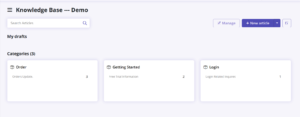
Tip of The Day: You can create an internal knowledge base for your agents to easily create, search and edit relevant customer service scripts.
3. Respond Quickly to Your Customers
As agents are guided with the help of customer service scripts they can respond quickly to the customers resulting in enhanced customer experience. The outcome might differ if agent would not have luxury to use them.
They could be caught off guard as they would not know the answer to the customer query, they might also not be able to manage the frustrated customer without the help of scripts. So, always make sure that agents use scripts as it not only helps them respond faster but also helps them to stay on top of their game.
4. Minimizes the Service Team’s Stress
Let’s be honest, offering high-quality customer service is not a piece of cake. It’s an extremely stressful job as you come across all types of customers. But it definitely gets a lot easier with the help of customer service scripts.
It helps agents stay on top of complex situations, as they know how to respond to the customers. Your agents no longer have to deal with impatient and frustrated customers because scripts help them a lot in controlling everything effectively.
Hence, when your agents are well-equipped with positive customer service scripts, they’ll naturally be less frustrated.
5. Enhances Agent Confidence
Sometimes agents get stuck in a situation where they do not what to say in response to the customer’s query. In such situations, they might feel less confident, which might also affect their customer service scripts role-play. And the situation might get even worse than it was before.
Hence, to overcome such situations, agents can take the help of customer service scripts. These scripts can guide them to effectively deal with such situations without losing their confidence.
Disadvantages of Using Customer Service Scripts
1. Customers Can Easily Identify a Script
Robotic tones will not work with customers. They can sense it when a support agent is providing a live experience or simply reading a script. Although they might not tell you, they can quickly lose interest in the conversation.
Customer service scripts can make an agent appear non-human or robotic. This can prevent them from fostering a real connection. To avoid these downfalls, agents have to find the right balance to offer quality customer service. Hence, you must encourage your agents to use an empathetic tone for better flexibility.
2. Agents Rely Too Much on Scripts
Customer service scripts are handy, but relying too much on them may not give your agents the ability to carry a natural conversation. They might struggle to keep the conversation alive and going during face-to-face interactions.
3. Lack of flexibility
Customer support reps who are passionate may feel that scripts prevent them from modifying the conversation with customers. This, in turn, would prevent them from creating a stronger connection with the customers. Hence the lack of flexibility arises.
4. The Human Touch Might Get Lost
Agents might not feel empowered to say something that is out of the script to satisfy customer needs. Hence, can end up losing the human touch that is very crucial in customer service. After using the script, they won’t be able to empathize with the customers. Customer service is all about handling situations and finding solutions for customers.
To keep everything normal, agents sometimes need to do something out of the ordinary, they need to go an extra mile for their customers. But this might not be possible if they follow the customer service scripts. So, it’s crucial for agents to find the right balance between keeping the human touch alive and using customer service scripts.
5. Customer Experience is not Personalized
When agents just stick to the script there is no room left for personalization. Customers nowadays want businesses to offer them personalized experiences, as, 80% of consumers are more likely to buy from a company that provides a tailored experience.
But if the agents are following the script, how will they offer personalized experiences to their customers? It is not possible. This is where using a script might prove to be an area of concern for businesses.
How to Overcome This?
The only way to resolve this is personalization. Allow your agents to personalize their responses as and when they need. Give them the flexibility to change scripts as they need in times of adversity.
Positive Scripting & Best Practices
Positive customer service scripting is designing a customer service script to limit customer frustration and steer the conversation towards a solution rather than fixating on the problem. Positive scripting can be used to help customers and guide them toward the desired outcome. For instance, support reps can use positive words to persuade customers into buying more products and services from the brand. Here are some best practices for positive scripting.
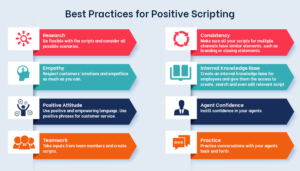
Use More Affirmative Phrases
Positive customer service phrases can create magic. You just need to know what to use and when. You can enhance customer engagement, reduce the overall churn rate, and increase customer satisfaction rate, simply by using the correct phrases. Exciting, right?
When you have the right collection of phrases at your disposal, it can improve your communication as a customer service professional. Here are some customer service scripts samples of affirmative phrases that you can use for live scripts that’ll make customers happy:

Avoid Using Negative Phrases
Words have the potential to destroy as much as they can empower. With the flash of the word “NO,” the human brain releases stress-producing hormones and neurotransmitters. Yes, customers do not appreciate the use of negative phrases while interacting with a customer service rep.
You must avoid using non-affirmative words during chat conversations, or it will end up being the last conversation. Additionally, negative words may sound rude and worsen the customer experience. Or worse, you might lose potential customers, and negative word of mouth might further reflect negatively on your brand.
Here are some of the negative to positive scripting while writing customer service scripts:
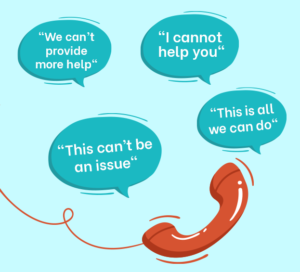
More or less, just avoid saying “NO.” Even if you can afford to say no, do it affirmatively by using positive words. You can suggest other resources instead of saying no.
Let me walk you through a wonderful example of winning a customer’s heart affirmatively after turning down their demand.
Company Name: Proposify, A SaaS Company
The CEO of Proposify noticed that a customer was constantly complaining about the software. He noted that the customer was asking for solutions that were not possible to fulfill. After weeks of continuous complaints, the CEO decided to talk to the customer directly. This is the power of being affirmative!
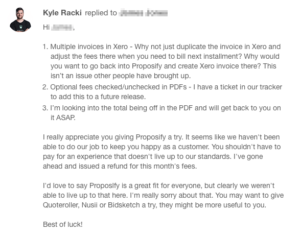
Image Source
The CEO apologized for this company’s inability to meet the customer’s needs and also offered to provide a refund along with competitors that the customer should try. An ideal way to say NO”. To his surprise, the CEO got the following response:
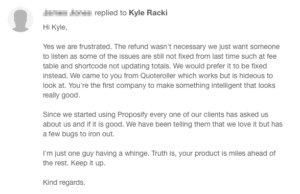
Image Source
It is a perfect example and a proper blend of empathy, diplomacy, and affirmation to de-escalate any issue. If you work for the customer’s best interest, the customers will know, and they’ll be delighted. In the beginning, it seemed like Proposify would lose a customer, but they gained a loyal customer and a valuable testimonial instead.
Amazing, right?
8 Effective Tips to Build Smart Customer Service Scripts
You must build your customer service scripts carefully, or else it’ll backfire. Here are a few tips to keep in mind while building and using scripts:
1. Understand Your Customers and Their Issues
If your scripts miss making your support efficient and miss customer challenges, there’s no point in having them in the first place. The most crucial task to craft scripts is to understand where the customers are coming from.
So, you must put yourself in the customer’s shoes and gauge their needs and overall mindset. This helps to ensure that your scripts do not sound tone-deaf.
2. Search for the Most Frequent Customer Service Scenarios Scripts
Searching for the most frequent customer service scenarios scripts might be the easiest way to create a smart customer service script. The frequent scenarios will give you an exact idea about what kinds of queries are generally raised by the customers.
Once you know which queries are generated the most, it gets easy to create customer service scripts. By following this method, you will know exactly what to include and importantly what not to in your scripts.
3. Leverage the Power of Positive Scripting
Positive scripting is the process of customizing scripts and mapping them to specific situations. It ensures that agents are able to keep the conversation going. You must spend time identifying different scenarios that support agents might find themselves in and build scripts accordingly.
Positive scripting is extremely useful for training recruits. You can make these scripts easy to access by deploying an agent-facing chatbot. This way, newly joined agents can interact with the chatbot to find the best thing to say.
4. Build Flexibility into Your Scripts
As scripts are mostly used to tackle complex situations, it is a must to create flexible scripts. Avoid making scripts that sound robotic, that do not include answers to the customer’s concerns, scripts that are vaguely created, etc. It might be of no use and might up making the situation even worse for you. So, in order to create smart and effective customer service scripts, make sure that you create them by keeping flexibility in mind. Then and only then, agents can use it to its full potential.
5. Analyze Your Previous Interactions with Customers
You can learn a lot from support agents who consistently maintain higher customer satisfaction scores. Listen to the recordings of these conversations.
Notice the nuances in how they speak and interact with customers and incorporate the learnings in your scripts. You can even borrow words or phrases from these conversations.
6. Engage with the Senior Members of Your Team
Customer service is a complex job. Sometimes so complex that agents might require the help of seniors. Seniors bring a lot of experience to the table. In their vast journey, there might not be any complex situations that they have not faced before.
Hence, to tackle complex situations, agents can take the guidance of their seniors. The same goes for customer service scripts. To make the script effective, agents can take their help. This way, without any fuss agents can successfully create quality customer service scripts.
7. Take Help of Third-party Resources
Creating customer service scripts vaguely makes no sense. These scripts help agents to handle complex situations and frustrated customers. So, if you create these scripts without including every important factor, they are of no use.
That is why, it is crucial to take the help of third-party resources. These resources will give you a better understanding of how a smart customer service script is made. And what factors you need to include in it to make it concise. One such example of a third-party resource can be the script examples that we have created just for you.
8. Ensure to Keep the Script in a Conversational Format
Customer service scripts are meant to help the agents, but if they are not created in a conversational manner they won’t be of any help to them. As customers would successfully recognize that agents are using a script that they use to solve every other customer’s issue. It might make your customers feel less valued. Every customer wants special treatment from the business they engage with.
And using a script might give them a totally opposite impression. So, how to achieve two things (making customers feel special and letting agents use scripts) with one simple solution? Make your customer service scripts in a way that they sound conversational. Make it simple and keep room for personalization. This way it gives a little flexibility to the agents.
Customer Service Scripts: Yay or Nay?
In the end, it all comes down to how the scripts are used. If you use them correctly, they drastically improve agent productivity. The key is in finding the right balance between being too flexible and too rigid. Plus, it also depends on the flexibility of your helpdesk tool and how often it lets you update customer service scripts.
15+ Ready-to-Use Customer Service Scripts
1. While Greeting a Customer
I. Welcome to [Brand Name] Customer Service. My name is [First Name]. How can I help you?
II. Good afternoon! You’re through to [Brand Name]. My name is [First Name]. How may I assist you today?
III. Hello [First Name], welcome back to [Brand Name]. Did you face any further problems with the “earlier issue”?
2. Informing Customers that the Call is being Recorded
I. Is it okay with you if I put this call on the recording? We usually use this for our internal training process.
II. I would like to mention that we will be recording this chat for the internal training process. Can you confirm if you’re okay with it or not?
III. Hello, we would like to let you know that this chat/call is monitored or recorded for quality assurance. Please confirm if you’re okay with your call being recorded or not.
3. Asking for Customer’s Contact Details
I. Hi [First Name]. Can you please share your contact details?
II. Hello [First Name], can I please have your contact details to update the process further? Could you kindly provide your phone number, email, etc.?
4. Post-sales Support to Customers
I. Hi [First Name]. Would you like to know more about the subscriptions for [another product or service name]? I can share the details if you want.
II. Hi [First Name]. Do you need help with the installation of [Product name]? I can help with it.
5. Asking What Brings Them to Your Brand
I. Hello [First Name], What brings you to [Brand Name]? What are you looking for? It will help us to serve you better.
II. Good morning [First Name], What brings you to [Brand Name]? Tell us about the source of your problem, and we’ll get back with a solution that works at the earliest.
6. When You Need to Apologize
I. We’re sorry about the issue. Let me have a word with my manager to find out how we can fix this for you. We’ll get back to you as soon as possible.
II. We apologize for the inconvenience you have faced. We’re very sorry. We will take care of the issue on top priority for you.
7. When Transferring the Call to Another Department
I. Thank you for reaching out [First Name]. The [Department Name] team is better qualified to resolve the issue. So, kindly hold while I connect you with them now.”
II. Sorry [First Name], for the inconvenience caused, but you seem to have connected to the wrong department. Let us help you connect to the right team.”
III. Thank you for bringing this to our attention [First Name]. But I am not the right person to help you out. Let me try and connect you to the right department.
8. When the Issue is Unsolved, but the Customer is Frustrated
I. Hello [First Name], I apologize for your bad experience. I know how frustrating it can get. But I assure you we will resolve your issue quickly.
9. Following Up with the Customers
I. Appreciate your patience [First Name]. I’m extremely sorry that we could not find a quick solution, but our senior representatives will now manage your issue. But we assure you that your issue will be solved within 2 business days.
II. Hi [First Name], just wanted to know your experience with our [Product Name]. We hope you’re having a good time with it. We’re just a call away in case of any queries.
III. Thank you for your cooperation as we work to resolve [Issue]. To know the status of your issue, you can click on the link sent to your email.
10. Asking Customers to Provide Additional Details
I. Thank you for reaching out [First Name]. Can you help me out with some additional information?
II. Can you kindly tell us more about the issue? Have you taken any steps to resolve the issue on your own?
III. Sorry for the inconvenience [First Name]. To register your issue, I will need a few more details. Can you kindly provide me with the same?
11. To Showcase Empathy Towards Customers
I. Sorry to hear about that [First Name]. This kind of situation would frustrate me too.
II. I can completely understand your situation. It’s always a bad experience when you face an issue. We are extremely sorry and we hope you never face such issue again.
III. We are extremely sorry for the inconvenience. It’s never a good feeling to be in such a situation.
12. When You Need to Say “No” to Your Customers
I. We totally understand your issue. However, right now, we’re unable to find a solution.
II. Sorry for the inconvenience [First Name], but we won’t be able to help you on that. If you have any other issue, feel free to contact us.
13. Making a Realistic Promise to Customer
I. We are extremely sorry to hear you are facing this issue. We will communicate further will other department and solve your issue as soon as possible.
II. Thank you for bringing this to our attention. We will ensure that your issue is resolved within the next 24 hours.
14. Concluding the Call for a Bad Experience
I. Once again, we are extremely sorry for the inconvenience caused. You are a valuable customer to us. We assure you this won’t happen again.
II. Goodbye, Sam! We will try our best to avoid such instances from happening again. I hope you have a good day ahead.
15. When the Customer Query is Resolved
I. Thank you so much for your patience [First Name]. We really appreciate it! I hope you have a great experience here onwards. Kindly feel free to contact at any time in case of any queries.
II. Thank you for your cooperation [First Name]. We hope you never face such issues again. Can you share your feedback regarding your current experience?
Final Thoughts: Customer Service Script
So, whether you are training new customer support reps or trying to bolster your support for your team, having ready customer service scripts will constantly improve both your customer and support rep’s experience. Make sure you have the right tools and technology at your disposal. Work with tech experts.
DeskXpand to serve the perfect customer support experience
Bring together a lucrative strategy with the right helpdesk software

![8 Effective Tips to Build Smart Customer Service Scripts [+5 Advantages] 8 Effective Tips to Build Smart Customer Service Scripts [+5 Advantages]](https://www.deskxpand.com/wp-content/uploads/2023/07/Blog_8-Effective-Tips-to-Build-Smart-Customer-Service-Scripts-5-Advantages-663x427-1.jpg)











